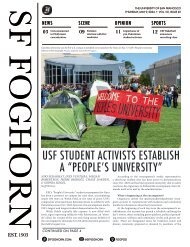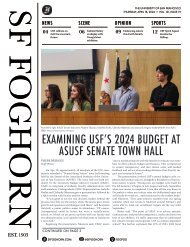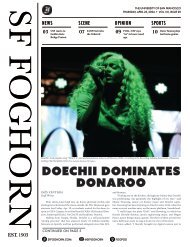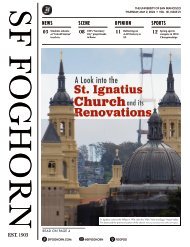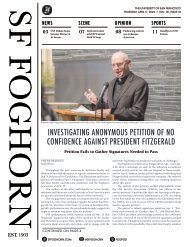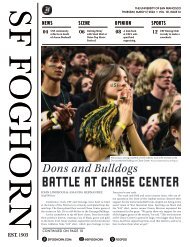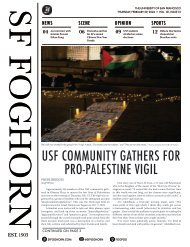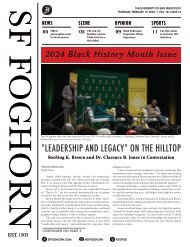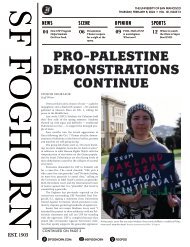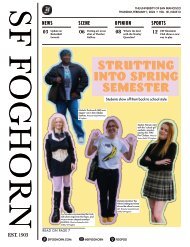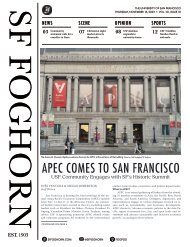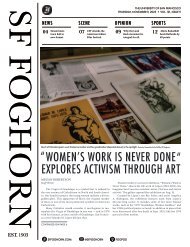NEWEST FOGHORN
You also want an ePaper? Increase the reach of your titles
YUMPU automatically turns print PDFs into web optimized ePapers that Google loves.
SF <strong>FOGHORN</strong><br />
EST. 1903<br />
120<br />
YEARS<br />
OF THE<br />
THE UNIVERSITY OF SAN FRANCISCO<br />
THURSDAY, DECEMBER 7TH, 2023 • VOL. 121, ISSUE 11<br />
ANNIVERSARY ISSUE<br />
<strong>FOGHORN</strong><br />
SF<strong>FOGHORN</strong>.COM<br />
Warren Hinckle: Journalism’s “Pirate” Icon<br />
— page 6<br />
“You never forget your first love” Carl Nolte<br />
Reflects on the Foghorn — page 8<br />
@SF<strong>FOGHORN</strong><br />
FOGPOD
02 03<br />
THURSDAY<br />
DEC. 7<br />
2023<br />
STAFF<br />
Editor in Chief<br />
MEGAN ROBERTSON<br />
mrrobertson2@dons.usfca.edu<br />
News Editor<br />
NIKI SEDAGHAT<br />
nisedaghat@dons.usfca.edu<br />
Opinion Editor<br />
CHISOM OKORAFOR<br />
cokorafor@dons.usfca.edu<br />
Scene Editor<br />
JORDAN PREMMER<br />
jepremmer@dons.usfca.edu<br />
Sports Editor<br />
CHASE DARDEN<br />
cbdarden@dons.usfca.edu<br />
Photography Online Editor Editor<br />
LEILA ESHA TSELNER DUPUGUNTLA<br />
latselner@dons.usfca.edu<br />
ekdupuguntla@dons.usfca.edu<br />
General Reporter<br />
JORDAN TYLER MARALIT<br />
jcmaralit@dons.usfca.edu<br />
General Reporter<br />
JOR 415.422.5444<br />
DAN sffoghorn.com TYLER MARALIT<br />
jcmaralit@dons.usfca.edu<br />
SUBMISSION POLICY<br />
The San Francisco Foghorn is the<br />
official student newspaper of the<br />
University of San Francisco and<br />
is sponsored by the Associated<br />
Students of the University of San<br />
Francisco (ASUSF).<br />
The thoughts and opinions<br />
expressed herein are those of the<br />
individual writers and do not<br />
necessarily reflect those of the<br />
Foghorn staff, the administration,<br />
the faculty, staff or the students of<br />
the University of San Francisco.<br />
Contents of each issue are the sole<br />
responsibilities of the editors.<br />
An All-American<br />
Publication<br />
ad maiorem dei<br />
gloriam<br />
The San Francisco Foghorn is free<br />
of charge.<br />
Advertising matter printed herein<br />
is solely for informational purposes.<br />
Such printing is not to be construed<br />
as written or implied sponsorship<br />
or endorsement of such commercial<br />
enterprises or ventures by the San<br />
Francisco Foghorn.<br />
©MMIV-MMV, San Francisco<br />
Foghorn. All rights reserved. No<br />
material printed herein may be reproduced<br />
without prior permission<br />
of the Editor in Chief.<br />
SAN FRANCISCO<br />
<strong>FOGHORN</strong><br />
Freedom and Fairness<br />
Managing Editor<br />
JORDAN DELFIUGO<br />
jgdelfiugo@dons.usfca.edu<br />
Copy Editor<br />
INÉS VENTURA<br />
ipventura@dons.usfca.edu<br />
Layout Editor<br />
AVA LORD<br />
ajlord@dons.usfca.edu<br />
Layout Editor<br />
ANYA JORDAN<br />
arjordan@dons.usfca.edu<br />
Social Media Manager<br />
MARIA ZAIED<br />
mfzaied@dons.usfca.edu<br />
Photography Editor<br />
SAMANTHA AVILA GRIFFIN<br />
svavilagriffin@dons.usfca.edu<br />
ADVISOR<br />
TERESA MOORE<br />
2130 FULTON STREET, UC #417<br />
SAN FRANCISCO, CA 94117<br />
Columns for the Opinion section<br />
and Letters to the Editor are gladly<br />
accepted from students, faculty, staff<br />
and alumni.<br />
All materials must be signed and<br />
include your printed name, university<br />
status (class standing or title),<br />
address, and telephone number for<br />
verification. Anonymous submissions<br />
are not published.<br />
We reserve the right to edit materials<br />
submitted. All submissions<br />
become the property of the San<br />
Francisco Foghorn.<br />
Staff editorials are written by the<br />
Foghorn editorial staff and represent<br />
a group consensus.<br />
The San Francisco Foghorn Opinion<br />
page is a forum for the free, fair and<br />
civil exchange of ideas. Contributors’<br />
opinions are not meant to<br />
reflect the views of the Foghorn staff<br />
or the University of San Francisco.<br />
Students interested in contributing<br />
to the Foghorn can scan and fill out<br />
the QR code below.<br />
Dear Readers,<br />
LETTER FROM<br />
THE EDITOR<br />
CELEBRATING 120 YEARS<br />
OF THE <strong>FOGHORN</strong><br />
Corrections Box<br />
We are pleased to share with you<br />
our special 120th anniversary edition<br />
of the San Francisco Foghorn. The<br />
Foghorn is one of the oldest institutions<br />
on the Hilltop. According to<br />
USF archivist Annie Reid, the Gleeson<br />
Library Archives have a substantial<br />
gap in their printed materials collection<br />
during the early 1900s, likely<br />
due to their destruction in the 1906<br />
earthquake and fire, and the subsequent<br />
relocations of the University<br />
campus.<br />
The earliest campus newspaper in<br />
the archives goes back to 1926 and<br />
was called “The Ignatian,” a name<br />
which you will notice was borrowed<br />
from USF’s literary magazine. According<br />
to USF Historian Emeritus<br />
Alan Ziajka in his 2004 book, “Legacy<br />
and Promise: 150 Years of Jesuit Education<br />
at the University of San Francisco,”<br />
the paper began publishing as<br />
“The San Francisco Foghorn” in 1928<br />
— 95 years ago.<br />
The San Francisco Foghorn arrived<br />
at a starting year of 1903 based<br />
on the volume and issue numbers<br />
that are printed on each issue’s front<br />
page. In 2003 the Foghorn published<br />
its 100th volume and celebrated 100<br />
years of the Foghorn. Despite the<br />
gaps in the archives, we are keeping<br />
with that tradition and celebrating<br />
120 years of reporting the stories of<br />
life at USF.<br />
In this special anniversary issue,<br />
you’ll be taken back in time to learn<br />
what the culture of USF and of the<br />
Foghorn was like in every decade<br />
since the 1950s.<br />
Since its inception, the Foghorn<br />
has been a channel for understanding<br />
events happening on campus, in San<br />
Francisco, and around the world.<br />
Throughout the history of the paper,<br />
Foghorn reporters have interviewed<br />
members of the Rolling Stones<br />
and the rapper and actor Common,<br />
attended the second March on Selma,<br />
covered the 1960 Winter Olympics,<br />
and even interviewed United States<br />
Presidential candidates.<br />
This anniversary edition features<br />
some of the most well-known figures<br />
who once churned out the paper —<br />
Warren Hinckle, one of the founders<br />
of gonzo journalism; Pierre Salinger,<br />
President John F. Kennedy’s press<br />
secretary, Gordon Bowker, co-founder<br />
of Starbucks, and Carl Nolte, the<br />
author of the San Francisco Chronicle’s<br />
“Native Son” column. Amanda<br />
Andrade-Rhoades, a former Foghorn<br />
photography editor, was part of a<br />
team of Washington Post reporters<br />
and photojournalists who were<br />
awarded the 2021 Pulitzer Prize for<br />
their coverage of the Jan. 6 Insurrection.<br />
On behalf of the entire editorial<br />
team, I want to thank all of the Foghorn<br />
alumni who spoke with us for<br />
this issue. We also extend thanks to<br />
USF archivist Annie Reid along with<br />
her predecessors at Gleeson Library.<br />
This anniversary edition would not<br />
be possible without their meticulous<br />
preservation work.<br />
The authors of the oldest surviving<br />
USF newspaper in the archives<br />
wrote,“this publication, being a student<br />
product, will have to be sustained<br />
by student cultivation; let us<br />
hope that cultivation will be unanimous<br />
and whole-hearted.” Our hope<br />
is that for the next 120 years of the<br />
Foghorn, student journalists will<br />
continue this mission with their<br />
whole hearts.<br />
Sincerely,<br />
Megan Robertson<br />
Editor-in-Chief<br />
There were errors in our Nov. 16 article, “800 USF Community Members Call for<br />
Cease-fire in Gaza.” Professor Saera Khan is a psychology professor and President<br />
Father Fitzgerald, S.J. released an Oct. 9 and Oct. 18 statement. Julia Laverde<br />
was misquoted.<br />
In the headline of our Nov. 16, “Will Barbara Lee’s Palestine Stance put her<br />
ahead?” op-ed, Barbara Lee’s name was misspelled. This is the correct spelling.<br />
Headshots contributed by those<br />
who interviewed. Headlines and<br />
graphics from past editions of the<br />
Foghorn. Courtesy of Gleeson Library<br />
Archives.<br />
20<br />
20s<br />
Chase Darden<br />
Staff Writer<br />
2010s<br />
Megan Roberston<br />
Staff Writer<br />
In the 2010s, the<br />
Foghorn honed in on<br />
investigative reporting on<br />
the Hilltop. Miles Herman,<br />
the Foghorn’s layout editor<br />
from 2017 to 2019, recalls<br />
Katie Ward, the editor-inchief<br />
his freshman year, as<br />
“set[ting] the groundwork<br />
for people to start, like,<br />
you know, caring about<br />
what you’re writing in the<br />
Foghorn.” This continued,<br />
Herman noted, under the<br />
tenure of subsequent editorin-chiefs<br />
Ali DeFazio and<br />
Gabriel Greschler. “We had<br />
a really good run of kids<br />
who were really interested in<br />
doing legit journalism at the<br />
school,” Herman said. “We<br />
had a good string of editorin-chiefs<br />
that kind of built<br />
off of each other.”<br />
Gabriel Greschler<br />
worked on the Foghorn’s<br />
staff from 2016 to 2019. He<br />
worked as opinion editor<br />
and news editor before<br />
taking on the role of editorin-chief.<br />
For Greschler, the<br />
SF <strong>FOGHORN</strong><br />
Gabriel Greschler<br />
Editor-in-Chief, News &<br />
Opinion Editor 2016 - 2019<br />
Miles Herman<br />
Deputy Photographer,<br />
Layout Editor 2017-2019<br />
Julian Sorapuru ’22,<br />
arrived at USF without<br />
previous journalistic<br />
experience or a clear idea of<br />
what he wanted as a career.<br />
But after writing his first<br />
story for the Foghorn, a<br />
women’s soccer game recap,<br />
Sorapuru said he thought<br />
the Foghorn was the “coolest<br />
thing ever.”<br />
After working as a<br />
general assignment reporter<br />
and news editor, Sorapuru<br />
became editor-in-chief as<br />
a second semester junior,<br />
becoming the first Black<br />
male to hold this position at the Foghorn.<br />
Reflecting on the impact of that title and<br />
his aspirations within that role, Sorapuru said<br />
“I definitely wanted to increase the amount<br />
of ‘Blackness’ in the paper, essentially.”<br />
He continued, “I heard from a lot of<br />
my Black peers on campus, they felt like no<br />
one was representing them, and also that,<br />
whenever there are ‘Black stories’ in the<br />
Foghorn, people [were] getting them wrong,<br />
they weren’t culturally sensitive, etc.”<br />
Sorapuru was tasked with leading<br />
the Foghorn during the unprecedented<br />
time of the COVID-19 pandemic, during<br />
which the newsroom transitioned to a fully<br />
remote workplace, as students, faculty,<br />
Foghorn “was the thing that<br />
made college really worth it<br />
for me,” he said. “I loved the<br />
camaraderie that came with<br />
it. Like it sort of felt like we<br />
were this force, and we had<br />
to, you know, sort of uncover<br />
things.”<br />
One of the most notable<br />
stories from this era was<br />
Herman’s Oct. 2018 article<br />
“USF Bought a Farm,” which<br />
investigated the finances<br />
and campus politics around<br />
the University’s purchasing<br />
of Star Route Farms in<br />
2017. He began the story in<br />
a Journalism I course the<br />
semester prior. “I came back<br />
in the fall, and I was like, ‘oh,<br />
you know, I should check<br />
in on this and then maybe<br />
we put it in the Foghorn,’”<br />
Herman said. The piece<br />
was finalized while Herman<br />
was taking Investigative<br />
Reporting. The response<br />
was powerful for Herman.<br />
“It’s hard, even though<br />
you’re doing real journalism<br />
to be like, feeling like it’s a<br />
Julian Sorapuru<br />
Editor in Chief, News Editor<br />
2020-2021<br />
and staff dispersed across<br />
the country. The Foghorn<br />
continued to release weekly<br />
issues.<br />
Sorapuru said “I felt<br />
like it was really important<br />
to put out the news during<br />
the pandemic because we<br />
weren’t on campus…When<br />
it came to stuff like, things<br />
that the administration<br />
was deciding to do, it<br />
was especially important<br />
because, a lot of people<br />
aren’t gonna check the email<br />
that administration sends<br />
out, or other things that<br />
haven’t had any votes or communication.”<br />
Sorapuru now works as a development<br />
fellow for the Boston Globe. He cites his<br />
experience at the Foghorn as being “vital,<br />
and impactful” to where he is today.<br />
In his reflections on 120 years of the<br />
Foghorn, he believes there is still more<br />
ground to cover.<br />
“I hope it continues to diversify and be<br />
reflective of the student experience, meaning<br />
all identities, not just racial,” he said. “We’re<br />
trying to be as reflective as possible as<br />
every newspaper whose goal is to reflect the<br />
community’s values… I hope [The Foghorn]<br />
never goes away.”<br />
significant thing, or it’s causing any change,”<br />
he said. “With that story, for sure, it did feel<br />
like it changed stuff, which was nice.”<br />
Greschler said, “I hope that the Foghorn<br />
continues to hold the University accountable<br />
and shed light on issues that are important.”<br />
Today Greschler is the San Jose City<br />
Hall reporter at the Mercury News, a San<br />
Jose, Calif. based newspaper, and Herman is<br />
a commerce producer for Dotdash Meredith,<br />
America’s largest digital and print publisher.<br />
NEWS
04 05<br />
THURSDAY<br />
DEC. 7<br />
2023<br />
2000s<br />
Jordan Premmer<br />
Staff Writer<br />
The San Francisco<br />
On Sept. 19, 2002, the Foghorn<br />
released its first post-9/11 cover<br />
story, which detailed students and<br />
faculty joining together at a Mass<br />
of the Holy Spirit to commemorate<br />
the tragedy, many stood as all St.<br />
Ignatius’ seats were filled.<br />
Benice Atufunwa served<br />
as editor-in-chief from 2005-<br />
2007, and opinion editor<br />
for her first two years in the<br />
Foghorn.<br />
Under Atufunwa’s<br />
leadership, the Foghorn was<br />
committed to uncovering the<br />
truth in her favorite story she<br />
worked on at the Foghorn —<br />
reporting on student theft<br />
in the cafeteria. “We kind<br />
of got in trouble from the<br />
administrators because they<br />
said we were encouraging<br />
stealing, which was not true,”<br />
Atufunwa said. “But on the<br />
other hand, a lot of students are like, ‘Oh my<br />
gosh, I didn’t know that was such a problem,’<br />
and found the story to be very informative.”<br />
In 2005, Atufunwa became the first<br />
Black editor-in-chief in Foghorn history, but<br />
she doesn’t view that as something to brag<br />
about. “I don’t like those, you know, first this<br />
or first that because it’s not like, there was<br />
never ever I don’t know, a Black woman who<br />
was capable of being the editor-in-chief until<br />
I got there,” she said. “I actually didn’t know<br />
that until well after the fact… I was like,<br />
‘There’s no way that’s true.’”<br />
Atufunwa noted the internet as the<br />
biggest change in the Foghorn since her<br />
time as editor-in-chief. “We just didn’t even<br />
think about social media at all. Not because<br />
it wasn’t there. But it’s just like Facebook,<br />
MySpace, those are all things you used to<br />
flirt with people, you didn’t<br />
have entities using it like<br />
you do now,” she said.<br />
Post-grad, Atufunwa<br />
went on to New York<br />
University for a graduate<br />
degree in magazine<br />
publishing. Today, she<br />
works at Squarespace as a<br />
content designer. Despite<br />
working in the tech<br />
industry, she keeps writing.<br />
“I’ve written for Essence…<br />
Good Housekeeping,” she<br />
said. “Now I just like to<br />
write stuff for myself.”<br />
Atufunwa reflected<br />
on how being in the Foghorn set her up for<br />
success in her future endeavors. “I was able<br />
to use the time I spent in the Foghorn and<br />
the articles that I’d written to get into grad<br />
schools and get internships,” she said. “It<br />
taught me a level of responsibility that I knew<br />
it was in me, but I didn’t have up until that<br />
point. It just taught me you have a duty to<br />
something that’s bigger than you,” she said.<br />
Benice Atufunwa<br />
Editor-in-Chief 2005-2007<br />
Jordan DelFiugo<br />
Staff Writer<br />
‘80s<br />
The Foghorn saw a period of computers<br />
and commentary in the late 1980s under the<br />
leadership of John Shanley, who served as<br />
editor-in-chief from 1988 to 1989.<br />
According to Shanley, 1988 was the first<br />
year the Foghorn went desktop, using Apple<br />
Macintosh to layout the paper on a computer<br />
as opposed to their previous practice, which<br />
involved using an exacto-knife on boards.<br />
“The first issue, especially, was very crazy<br />
and chaotic, because we had never done<br />
it that way before,” Shanley said. “But I do<br />
believe that’s the year the Foghorn really sort<br />
of came into the modern age.”<br />
A major goal of Shanley’s as editorin-chief<br />
was to introduce more diverse<br />
viewpoints to the paper.<br />
“The first thing I said to my<br />
editorial staff is ‘let there<br />
be no bounds. I want crazy<br />
left wing stuff, I want crazy<br />
right wing stuff. I want crazy<br />
diversity of thought.’”<br />
As 1988 was a<br />
presidential election year,<br />
Shanley described the<br />
Foghorn as being filled<br />
with election coverage<br />
and political commentary.<br />
Shanely even had the<br />
John Shanley<br />
Editor-in-Chief 1988-1989<br />
opportunity of interviewing<br />
Democratic presidential<br />
nominee at the time, Michael<br />
Dukakis, in a preview<br />
leading up to the election.<br />
“We also bashed George Bush a lot,”<br />
Shanley recalled. “On the last day of his<br />
campaign, I remember he toured a hot dog<br />
Rolling Stones<br />
and USF<br />
“We managed to talk the Rolling Stones<br />
into giving us tickets when they toured in<br />
‘89, and we got to interview their keyboard<br />
player, Chuck Leavell,” Shanley explained,<br />
“We got to have lunch with him and it was<br />
just really cool for, you know, a 21-year-old<br />
kid. Before that, [the Foghorn] wasn’t doing<br />
a lot of stuff like that.”<br />
factory, and on the front page of our election<br />
issue I wrote something to<br />
the effect of ‘I feel like [Bush]<br />
would best serve the country<br />
if he had just jumped into<br />
the hot dog vat while at the<br />
factory.’”<br />
Shanely said of the<br />
choice for the cover, “That<br />
wasn’t really something<br />
they would’ve run the year<br />
before.”<br />
After graduating,<br />
Shanley went into politics.<br />
He previously worked under<br />
former San Francisco Mayor<br />
Francis Jordan. Today, he<br />
works as a lawyer. Reflecting<br />
on his time at the Foghorn,<br />
Shanley said “I look back at it all very fondly,<br />
I sure don’t say ‘oh, that was a waste of time’…<br />
it was one of the more rewarding things I<br />
ever did.”<br />
NEWS<br />
‘90s<br />
Jordan DelFiugo & Megan Robertson<br />
Staff Writers<br />
Kent German, who served as the<br />
Foghorn’s editor-in-chief<br />
from 1995-1996 recalled<br />
that the paper’s 1990s<br />
staff rarely went home<br />
before the sunrise on<br />
editing nights. “We’d stay<br />
all night,” he said. “We<br />
were putting something<br />
together, and it really, in<br />
a lot of ways, was a labor<br />
of love.”<br />
German said that he<br />
would drive to Potrero<br />
Hill to pick up the paper<br />
from printers every week,<br />
distributing the papers on<br />
Kent German<br />
Editor-in-Chief, News Editor<br />
1994-1996<br />
campus in the early hours of the morning. “It<br />
was the greatest,” he said, “walking in and<br />
seeing people pick up the paper and go to<br />
class.”<br />
In 1990, the Foghorn reported on<br />
former University President John Lo Schiavo<br />
granting approval for the Institutional<br />
Policy on Freedom of Expression, which<br />
guaranteed “the right of every member of the<br />
University community free expression, free<br />
association, and free exercise of religion”<br />
when, previously, the Associated Students<br />
of the University of San Francisco (ASUSF)<br />
Senate was to object to the activity of any<br />
on campus groups which “actively foment<br />
against the Catholic Church’s conception of<br />
human dignity and justice.”<br />
With this new resolution in place, the<br />
Foghorn chronicled the efforts of student<br />
activist groups, such as Students<br />
for Choice, which petitioned<br />
the University to provide birth<br />
control education and services<br />
at the University Health Center,<br />
among other actions.<br />
In 1995, the Foghorn<br />
introduced the “CounterPoint”<br />
series, in which two op-eds<br />
with opposing arguments<br />
ran alongside each other.<br />
The first in the CounterPoint<br />
series featured two articles on<br />
contraceptives and the catholic<br />
church. The series would go on<br />
to cover topical events of the<br />
1990s, such as the Bill Clinton and Monica<br />
Lewinsky scandal in 1998.<br />
With regard to what German, who is now<br />
news editor for SF Gate, would like to see<br />
from the Foghorn moving forward, he said,<br />
“I hope it continues to be a place for young<br />
journalists to learn and get good experience<br />
that will take them into their careers.”<br />
Headshots contributed by those who interviewed.<br />
Headlines and graphics from past<br />
editions of the Foghorn. Courtesy of Gleeson<br />
Library Archives.<br />
‘ 70s<br />
Megan Robertson<br />
Staff Writer<br />
In 1976, the Alliance for<br />
Gay Awareness applied<br />
to the ASUSF Senate for<br />
official club status.<br />
In 1969, Joe Schieffer’s friend invited<br />
him to a meeting about the school paper.<br />
He didn’t know that this meeting would<br />
influence the rest of his time<br />
at USF. Schieffer worked<br />
as a Foghorn staff writer<br />
for his first four semesters<br />
at USF, and then as the<br />
Entertainment Editor for his<br />
last three semesters.<br />
The most notable story<br />
Schieffer remembers during<br />
his time at USF was the 1972<br />
“Pelosi V. Marks at FOG<br />
office — Propositions 3,8,19<br />
in question.” In the fall of<br />
1972, incumbent Republican<br />
Milton Marx and Democrat<br />
Ron Pelosi were running to<br />
represent California’s 9th<br />
District in the California State Senate. In the<br />
midst of the competitive race, the Foghorn<br />
was “thinking about endorsing someone for<br />
Joe Schieffer<br />
Entertainment Editor,<br />
Staff Writer 1969-1972<br />
that seat,” Schieffer said. Both candidates<br />
sought to secure the Foghorn’s endorsement,<br />
so in October of 1972 they had a debate in<br />
the paper’s office, trying to<br />
sway the six editors. “We<br />
couldn’t agree on who the<br />
endorsement would be for,”<br />
Schieffer said. The Foghorn<br />
refrained from endorsing<br />
either candidate due to their<br />
lack of consensus. Marx<br />
ended up winning the seat.<br />
The Foghorn was a staple<br />
on campus and in the Bay<br />
Area community,” Schieffer<br />
recalled. “There was no<br />
alternative to hardcopy…the<br />
copies would disappear off<br />
the racks where they were<br />
placed.”<br />
Schieffer, 72, is today a retired attorney<br />
who lives in Oakland.<br />
NEWS
06 07<br />
THURSDAY<br />
The Foghorn<br />
DEC. 7<br />
2023<br />
in the 1960s<br />
SCENE<br />
Warren Hinckle:<br />
Journalism’s<br />
“Pirate” Icon<br />
Inés Ventura<br />
Staff Writer<br />
Warren Hinckle pictured during his time at USF.<br />
Photo courtesy of Pia Hinckle.<br />
“During his time as editor,<br />
Warren Hinckle famously<br />
turned the Foghorn into a<br />
daily publication, the first<br />
of its kind in the U.S.”<br />
Warren Hinckle left a mark on American journalism as a<br />
maverick editor and writer. Being one of the most famous editors<br />
that the Foghorn has ever seen, Hinckle was known for his strong<br />
personality, steadfast determination, love of drinking, fearless<br />
approach to life, and for his eyepatch — which he wore due to<br />
losing his left eye in an accident during his childhood. Throughout<br />
his life, Hinckle accomplished many feats “with all kinds of lunacy<br />
[that] nobody can get away with,” said his daughter Pia Hinckle.<br />
“That’s why my dad was a pirate,” and journalism was his sea.<br />
Born in 1938 in the Sunset District of San Francisco, Warren<br />
Hinckle took an early interest in journalism and displayed a knack<br />
for questioning authority, which he applied to his work at the school<br />
newspaper of Archbishop Riordan High School. In his memoir “If<br />
You Have a Lemon, Make Lemonade,” Warren Hinckle recalled<br />
turning the newspaper into his “personal fiefdom to indulge my<br />
insatiable craving for the joys of printing.” His hunger for print<br />
was even deeper by the time he arrived at USF to study psychology,<br />
where he eventually became Editor in Chief of the Foghorn in 1960.<br />
His memoir also detailed his time at the Foghorn, where once<br />
during a dull news week, in an attempt to have something worth<br />
writing about, Warren Hinckle and his friend Brennan Newsom<br />
burned down a wooden guardhouse at the entrance of campus, and<br />
turned the event into a front-page editorial, heavy with calls upon<br />
the Dean of Students, Rev. Francis A. Moore, to expel whoever did<br />
it. Despite his suspicions, Fr. Moore had no evidence to prove that<br />
Warren Hinckle was behind the stunt, marking only the beginning<br />
of the cat-and-mouse dynamic that the two would have during<br />
Hinckle’s time at USF.<br />
During his time as editor, Warren Hinckle famously turned<br />
the Foghorn into a daily publication, the first of its kind in the<br />
U.S.; “which pissed off the [Jesuit] brothers to no end, because, of<br />
course, he did not ask permission,” said his daughter, Pia Hinckle.<br />
Warren Hinckle secretly wrote up a press release — “New Era of<br />
Journalism at USF: Foghorn Becomes First Catholic College Daily<br />
Newspaper in U.S.’’ — and handed it off to Foghorn alumnus Carl<br />
Nolte, USF’s Director of Public Information at the time, to secretly<br />
distribute to the media under Fr. Moore’s nose. Warren Hinckle’s<br />
plan to blindside the institution with headlines from well-known<br />
publications was foiled when Nolte decided to run the plan by Fr.<br />
Moore for approval first, which Fr. Moore immediately shot down.<br />
In retaliation, Warren Hinckle threw a party to celebrate<br />
its relaunch as a daily and invited various judges, city officials,<br />
prominent USF alumni, a high number of San Francisco reporters,<br />
and even congressmen in Washington D.C. to celebrate. He sent<br />
telegrams to every newspaper in the state with the announcement,<br />
many who later ran editorials congratulating USF on their big<br />
journalistic stride. According to Warren Hinckle’s memoir,<br />
Fr. Moore walked into the party looking pale in shock at the<br />
sight of drunk reporters, students, Jesuits, local politicians,<br />
and alumni raising toasts to the Foghorn. In a mix of pride for<br />
what he accomplished and satisfaction of knowing how angry he<br />
made Fr. Moore, Warren Hinckle handed him two telegrams of<br />
congratulations that he had received back from the slew that he<br />
sent out — from then-Vice President Richard Nixon and Senator<br />
John F. Kennedy.<br />
The Daily Foghorn ran sensational headlines like “Virginia<br />
City Priest Assaults 47-Year-Old Woman Polio Victim” and “ROTC<br />
General Attempts to Strangle Student,” rarely running stories about<br />
the school itself, as detailed in his memoir. He installed an AP wire<br />
to pick up on hotter stories to cover, much to the disapproval of the<br />
University. In 1960, Warren Hinckle assigned himself to cover the<br />
Winter Olympics in Squaw Valley, Calif., where he would telegram<br />
stories back to the Hilltop every night and ran the newspaper via<br />
telephone for two weeks.<br />
One Halloween, Warren Hinckle stole the press run of San<br />
Francisco State’s college newspaper, which led Fr. Moore to file<br />
grand theft charges against him. Fed up with Warren Hinckle’<br />
antics, the Administration repeatedly tried to cut off the Foghorn’s<br />
funds to stop him, which he fought with budget diversions.<br />
Near his graduation day, Warren Hinckle received a bill of<br />
$13,000 from the Dean, claiming that it was a Foghorn’s deficit he<br />
needed to pay personally in order to receive his diploma. He never<br />
did.<br />
“USF gave him the platform he needed to be what he became —<br />
a big success,” said Nolte, who later went on to work with Warren<br />
Hinckle as a fellow journalist.<br />
According to his daughter, Warren Hinckle’s time at the<br />
Foghorn was where his legacy of unorthodoxy in journalism really<br />
began. “Why wouldn’t you report on things that were distasteful<br />
to the administration? That’s the job of the press,” she said, when<br />
speaking on the mentality that Warren Hinckle worked with while<br />
at USF, and throughout his career.<br />
Hinckle’s career unfolded against the backdrop of the 1960’s<br />
with its turbulent and counterculture narrative, which coupled with<br />
his radical style of reporting allowed for him to forge his career<br />
as a gonzo journalist. After USF, he became a writer at the San<br />
Francisco Chronicle, then the executive editor of Ramparts, where<br />
he turned the subdued Catholic magazine into an award-winning<br />
publication with illustrated political and literary content, known<br />
for its sophistication and embrace of anti-war rhetoric. Despite<br />
the publication only lasting eight issues, its legacy as a muckraking<br />
magazine has been credited as the precursor to other publications<br />
like Rolling Stone, Mother Jones, and Slate.<br />
After transforming Ramparts, Warren Hinckle went on to<br />
create the journal Scanlan’s Monthly alongside journalist Sidney<br />
Zion in 1969. While at Scanlan’s, Warren Hinckle connected the<br />
famous duo Hunter S. Thompson and illustrator Ralph Steadman for<br />
the first time in an assignment which eventually became the 1970<br />
article “The Kentucky Derby is Decadent and Depraved,” credited<br />
as the first work of gonzo journalism. This new style of reportage<br />
placed the reporter as a protagonist in the story, and was unique in<br />
its combination of social commentary and self-satire. “[Thompson]<br />
made a lot of money off of it and made a lot of fame out of it, but it<br />
was a Foghorn editor that sent him to Kentucky and came up with<br />
the headline for the article,” said Foghorn 1980s staffer John Shanley<br />
In the 1980’s and 90’s he worked as a columnist at the Chronicle,<br />
the San Francisco Examiner, and the San Francisco Independant,<br />
where he created a reputation for turning stories on their head and<br />
pushing the buttons of local politicians. In 1987 he ran for mayor of<br />
Warren Hinckle displaying his famous rebellious spirit.<br />
Photo courtesy of Pia Hinckle<br />
Hinckle famously made the<br />
Foghorn a daily publication,<br />
the first of its kind in the<br />
U.S. in 1959. Foghorn excerpt<br />
from Gleeson Library<br />
Archives.<br />
San Francisco, not with the intention to win, but to gather insider<br />
information for his reporting about the mayoral election, according<br />
to his daughter Pia Hinckle.<br />
In 1991, Warren Hinckle revived The Argonaut and produced it<br />
out of his own apartment. “He had the publication bug,” said Chris<br />
Carson, a USF alumnus who worked with Warren Hinckle in 2010<br />
while he was still an undergraduate student. “I feel like if he wasn’t<br />
working at the high level that he was at, he would have just been<br />
another old-headed San Franciscan printing off zines, or handing<br />
out one page essays on the street,” said Carson.<br />
Warren Hinckle’s passion for print carried on through his<br />
writing projects until his death in 2016. Through his legacy, he<br />
inspired others with his fearlessness, and never awaited approval<br />
from anyone to do whatever he wanted. “Warren taught me that<br />
you don’t need to wait for that — you can make it yourself. Which<br />
is basically the philosophy of his entire career… he blazed his own<br />
path,” said Carson.<br />
Jordan DelFiugo and Drew Moss contributed to the reporting of<br />
this story.<br />
SCENE
08 All photos from past editions of the 09<br />
THURSDAY<br />
DEC. 7<br />
2023<br />
‘50s<br />
Oct 13, 1959<br />
Foghorn.<br />
Courtesy of Gleeson Library Archives.<br />
Drew Moss<br />
Contributing Writer<br />
Carl Nolte, who worked alongside former<br />
Lieutenant Governor and founder of the<br />
McCarthy center, Leo McCarthy, described<br />
his experience working as<br />
the Foghorn’s Sports Editor<br />
in the 1950s as “a kind of<br />
golden time.”<br />
“We were always up<br />
late, drinking beer and<br />
running down to the print<br />
place and trying to put it<br />
all together. So it was a<br />
perpetual rush,” Nolte said.<br />
“We had typewriters then, of<br />
course, and we [printed] the<br />
Carl Nolte<br />
Sports Editor, Staff<br />
Writer 1953-1955<br />
Foghorn in a hot type shop<br />
downtown.”<br />
Nolte said of his time at<br />
the Foghorn, “I learned how<br />
to write there.”<br />
He noted that sports writing for the 1950s<br />
was particularly exciting, due in large part to<br />
the talent on the Dons Men’s Basketball team<br />
at the time. “It was groundbreaking, with<br />
[Bill] Russel, KC Jones, and Hal Perry, and all<br />
those other ball players. So<br />
working on the Foghorn was<br />
good stuff.”<br />
He continued, “We won<br />
the NCAA Championship<br />
in 1955… It turned out to be<br />
that team and the ‘56 team<br />
were of the best in the history<br />
of college basketball.”<br />
The Foghorn also<br />
covered San Francisco’s<br />
opera scene, with Gordon<br />
Getty writing music reviews<br />
and conducting exclusive<br />
interviews. “Gordon would<br />
go out to the opera and he’d<br />
meet some of the famous<br />
performers like Kirsten Flagstad,” Nolte<br />
said, “we thought ‘wow we’re the only college<br />
paper covering the San Francisco opera,’<br />
where our other students thought the opera<br />
wasn’t so hot.”<br />
When asked what his future hopes for<br />
the Foghorn are, Nolte said “It should go on<br />
for another hundred years, to 220.”<br />
He continued, “College is like a river,<br />
the students keep changing but it has to keep<br />
going. So there are down periods and up<br />
periods, which is natural. We were lucky to<br />
come along at a good time.”<br />
Nolte, 90, has since been with the San<br />
Francisco Chronicle since 1961 and continues<br />
to write for his Sunday column, “Native Son.”<br />
Previously, he worked as an editor, reporter,<br />
and war correspondent. In 1986, he was<br />
awarded the Lifetime Achievement Award<br />
from the Society of Professional Journalists.<br />
Jordan DelFiugo contributed to the<br />
reporting of this story.<br />
Oct 20, 1959<br />
Feb 27, 1959<br />
This 1954 Map of USF<br />
shows the Foghorn’s old office,<br />
the now non-existent<br />
Loyola Lodge<br />
Sept 17, 1954<br />
“You never forget your first love”<br />
OPINION<br />
Carl Nolte Reflects on the Foghorn<br />
People remember their college days<br />
for lots of reasons — a favorite professor,<br />
friendships they made, studying all night<br />
once or twice, a sports championship the<br />
school won, the first day in college, the<br />
last day. Good times and bad. The part I<br />
remember best about USF is working on the<br />
Foghorn.<br />
I’m not sure why. Maybe it is because<br />
working on the Foghorn was fun, interesting<br />
and challenging. Maybe because I liked the<br />
name. “Foghorn” is a great name. We always<br />
spelled it in capital letters — <strong>FOGHORN</strong> —<br />
like the blast of a fog warning in your ear. We<br />
took ourselves seriously. Sometimes.<br />
Maybe it was because after my time at<br />
USF I went into newspapering and spent a<br />
lifetime in the business. I’m still at it, writing<br />
a column in the Sunday San Francisco<br />
Chronicle and online. You never forget your<br />
first love.<br />
It’s hard to imagine how different USF<br />
was in those days. The school was mostly<br />
male and the students were mostly local.<br />
Nearly everybody was a day student. A new<br />
residence hall was in the works, but boarding<br />
students lived in some old military facilities<br />
called “the barracks.’’ San Francisco was a<br />
smaller, tighter city than it is now. Everybody<br />
seemed to know everybody else. It was<br />
another time.<br />
But, we are celebrating 120 years of<br />
student newspapering at USF, so the story<br />
does come with a slice of history. Mine is a<br />
small slice: I came to USF as a transfer student<br />
from City College of San Francisco in the fall<br />
of 1953. I had considered Berkeley and maybe<br />
even Stanford, but I thought USF had style,<br />
class, and Jesuits. The others didn’t.<br />
It was a small school and welcoming,<br />
and I was pleased when I was able to work<br />
on the college paper. At first I covered small<br />
news stories, but got sent to the sports page.<br />
I managed to write about Bill Russell’s first<br />
game—a huge victory over a good Cal team.<br />
Eventually I managed to become the<br />
main sports editor and even wrote a sports<br />
column where I offered comment and free<br />
advice to the basketball team. It worked out<br />
pretty well, too — the first of two NCAA<br />
Championships.<br />
We thought it a golden era: the basketball<br />
team was on top of the world, and the Foghorn<br />
was pretty good, too. We had a lively and<br />
interesting paper and won some big awards<br />
from the college newspaper association of my<br />
time. That was in 1955. Ancient history.<br />
I learned about logic, politics, literature,<br />
and a bit of the classics in the classroom.<br />
But in the battered, messy Foghorn office,<br />
I learned that there were two sides to every<br />
story, that famous athletes had complex sides<br />
to them, that we wrote news stories about real<br />
people, who could be pleased, offended, hurt,<br />
or furious about what we wrote. I learned that<br />
words had power, and that there were shades<br />
to truth.<br />
Journalism seems to be in decline these<br />
social media days, but the ability to think<br />
clearly and to tell the truth as you best<br />
understand it will always be valued. That’s<br />
the kind of thing you learn on a college paper<br />
like the Foghorn.<br />
I still remember walking into the<br />
Foghorn office one afternoon. I said I was<br />
interested in writing for the paper. A scruffy<br />
looking guy was there. He seemed to be in<br />
charge of something. He didn’t ask me who I<br />
was or where I went to school. He just handed<br />
me some kind of form. “Fill this out and come<br />
back later,’’ he said. “We’ll give you a try.’’<br />
That’s what I liked best: USF gave me a<br />
chance.<br />
The Hilltop as seen in a vintage<br />
edition of the Foghorn. Courtesy of<br />
Gleeson Library Archives.<br />
‘40s<br />
AND<br />
BEYOND<br />
MAY 14, 1943<br />
MAY 14, 1943<br />
23 Dons had died in World War II<br />
MARCH 6, 1942<br />
The Foghorn took issue with the way<br />
campus clubs and activities were dying<br />
out at this time. They argued that the<br />
excuse of the war was not valid, especially<br />
for clubs like the International<br />
Relations Club<br />
MARCH 6, 1942<br />
“Italy, Germany and Japan are our<br />
enemies. The Italians, the Germans and<br />
the Japanese form the armies we must<br />
fight, the nations we must defeat. But<br />
lest we forget, not all Italians, Germans<br />
and Japanese are strictly our enemies;<br />
it is not Italian history, German culture,<br />
or Japanese art we are fighting.”<br />
• • •<br />
March 9, 1933<br />
During its Great Depression<br />
coverage,the Foghorn reported<br />
overheard student financial<br />
concerns from around campus.<br />
OPINION
10 11<br />
THURSDAY<br />
DEC. 7<br />
2023<br />
OPINION<br />
Karim Iliya, Foghorn alum, is heading to the moon<br />
as an accomplished photographer with a platform<br />
of over 198,000 followers on Instagram.<br />
Screenshot from https://karimiliya.com/.<br />
Fatima Duran Ramìrez is the executive director of<br />
Acción Latinas’ Mission Media Arts Center. Photo<br />
courtesy of LinkedIn.<br />
Pete Rozelle spent 30 years as commissioner of<br />
the National Football League. Photo courtesy of<br />
Pro Football Hall of Fame.<br />
CHISOM OKORAFOR<br />
Staff Writer<br />
The Foghorn’s history is full of figures that have<br />
gone on to be successful in their careers. Alan<br />
Ziajka, USF historian emeritus and author of four<br />
books on the University of San Francisco, said<br />
that “the members of the Foghorn staff are really<br />
some of our most exceptional students.”<br />
For many, working at the Foghorn acted as<br />
a springboard for a career in journalism and<br />
media. Class of ‘03 alumna and former Foghorn<br />
managing editor, Shadi Rahimi, now serves as<br />
an award-winning documentarian and executive<br />
producer for AJ+, a digital news project from Al<br />
Jazeera. Rob Fischer ‘05, is now a senior editor<br />
of The New Yorker. Fatima Duran Ramírez ‘12,<br />
former Foghorn news editor, is now the executive<br />
director at Acción Latina, the publisher of<br />
bilingual newspaper El Tecolote. Karim Iliya,<br />
‘12, is a photographer, ocean conservationist,<br />
and filmmaker headed to the moon as part of<br />
the SpaceX dearMoon project. Lucas Waldron<br />
‘13, now works as a graphics editor at ProPublica,<br />
and Amanda Andrade-Rhoades ‘14, was awarded<br />
the 2022 Pulitzer Prize for Public Service for her<br />
photojournalism for the Washington Post during<br />
the Jan. 6 Insurrection.<br />
Outside the realm of journalism, Foghorn<br />
alumnus Pete Rozelle ’50, served as the National<br />
Football League commissioner from 1960 to<br />
1989. According to the Pro Football Hall of<br />
Fame, he “guided the league through a period of<br />
unprecedented growth.” Sunny Angulo ‘04, now<br />
serves as the chief of staff to San Francisco Board<br />
of Supervisor President Aaron Peskin. Class of ‘08<br />
alumna Lulu McAllister Cunningham became a<br />
nationally recognized wine sommelier.<br />
Likely the most well-known Foghorn alumnus<br />
is the late Pierre Salinger, ‘47, who worked as the<br />
managing editor at the Foghorn in the late 1950s.<br />
After working at the Foghorn, Salinger became<br />
President John F. Kennedy’s press secretary,<br />
continuing the job under President Lyndon B.<br />
Johnson before becoming a California senator in<br />
1964. In 1968, Salinger appeared in an episode of<br />
the ABC show “Batman”, starring Adam West,<br />
and served as a features commentator for the<br />
same network.<br />
Gordon Bowker, co-founder of Starbucks Coffee,<br />
worked on the Foghorn’s staff from 1962 to 1965,<br />
as news editor, managing editor, and editor in<br />
chief. In 1965, Bowker famously sent a Foghorn<br />
reporter and photographer to cover the Second<br />
March on Selma. In 1971, the first Starbucks<br />
storefront opened.<br />
Ziajka said, “I would encourage no matter what<br />
your future career may be to spend some time<br />
with the Foghorn.”<br />
Kaleb Martinez contributed to the reporting of<br />
this story.<br />
Editor’s Note: The headline of this article is<br />
based on a 1961 Foghorn story of the same name,<br />
which highlighted the achievements of Salinger,<br />
along with Wilson O’Brien, ’30, Editor of the<br />
San Francisco Examiner, and James K McGee,<br />
‘30, a former sports writer and president of the<br />
San Francisco chapter of the Baseball Writers of<br />
America.<br />
Pierre Salinger was born in 1925 in San Francisco.<br />
Photo from JFK Library.<br />
Lucas Waldron went on to study at UC Berkeley’s<br />
Graduate School of Journalism post-grad. He has<br />
worked at ProPublica, KQED and The New York<br />
Times. Photo from USF Magazine<br />
Amanda Andrade-Rhoades is a Pulitzer Prize<br />
winning photojournalist living in Washington D.C.<br />
Photo courtesy of LinkedIn.<br />
A <strong>FOGHORN</strong><br />
EXCLUSIVE LOOK INTO<br />
THE THE SILK FAMILY<br />
HALL OF FAME<br />
JORDAN MARALIT<br />
Staff Writer<br />
The Foghorn got an exclusive look at The Silk Family Hall of<br />
Fame Museum, which is currently under construction and closed to<br />
the public. Located in the War Memorial Gym, the museum features<br />
memorabilia from student athletes, preserving the history of USF’s<br />
sports programs.<br />
The museum displays a timeline of notable sports events in USF<br />
history. Beginning with USF’s history as St. Ignatius College, when<br />
rugby and baseball were the most acclaimed sports teams, to the Men’s<br />
Basketball Team punching a ticket to the NCAA March Madness<br />
tournament.<br />
Assistant Athletics Director Chris Fortney said, “[The museum]<br />
is somewhere that not only we hope people can go and look at during<br />
games, but it’s an event space for us. The goal is to use it as a kind of<br />
multi-purpose area. Not only to use it as a hall of fame, but to have<br />
different alumni or donor events in that space.”<br />
Main Attractions<br />
The main attraction of the museum includes the two notorious<br />
basketball Bills: Bill Russell and Bill Cartwright.<br />
Russell led the Dons to the 1955 and 1956 NCAA championships<br />
and made the Dons an elite team of college basketball in the 1950s with<br />
55 consecutive games. Inside his individualized display is Russell’s<br />
USF jersey replica, his signed black All Star sneaker, his 1996 NBA<br />
Greatest Players Ring replica, and his own Wheaties box.<br />
Fortney said, “The NBA just retired Bill Russell’s number six<br />
across the board because he’s pretty much their Jackie Robinson,<br />
and it’s important for us to be able to honor that.” Celebrating his<br />
contributions, Russell became the face of USF basketball while sharing<br />
the stardom with Cartwright.<br />
Cartwright played center with great shooting ability and strength.<br />
According to Chris Fortney, the museum will have “a social justice piece added to it” which<br />
includes “the quality and things USF has done. Not only on the court and the people we’ve had<br />
on the court, but who they represent off the court.” Photo by Samantha Avila Griffin/SF Foghorn.<br />
Phil Smith, the 9th highest scorer in Don’s men’s basketball history, had his<br />
number 20 jersey retired in 2001. Photo by Samantha Avila Griffin/SF Foghorn.<br />
According to USF athletics, from 1975 to ‘79, he was college basketball’s<br />
“best big man.” His display consists of the 1978 Citizens Athletics<br />
Foundations Award, his number 24 USF jersey and 1980 NBA All-Star<br />
jersey, and the original Wheaties box commemorating the 1991-1993<br />
NBA champions Chicago Bulls.<br />
For Women’s basketball, Mary Nile-Nepfel received an<br />
individualized display, which consists of her 1981 basketball jersey and<br />
an early game photo. In 1986, she became one of the first women to<br />
have her jersey retired at USF. She was the all-time leader in points and<br />
rebounds at USF. Nile-Nepfel was the basketball coach for the Women’s<br />
Basketball team from 1987 to 2006 and currently is the Director of<br />
USF’s Kinesiology Physical Activity Program<br />
Trophies and Relics<br />
The museum showcased discontinued athletic programs, including<br />
USF’s football team, which was founded in 1917. On display are vintage<br />
football programs, a 1950s football schedule, ticket admissions, a St.<br />
Ignatius and USF pennant, and a football signed by the players.<br />
Also featured are various awards — a tennis championship single<br />
and team bowl from 1949, a James W. St. Clair trophy in 1954-55, and<br />
1975 and ‘76 soccer trophies. Also showcased was a photograph of the<br />
1973-74 volleyball team and women’s volleyball uniform from 1976-<br />
1977. Volleyball was one of USF’s five female intercollegiate sports at<br />
the time, with scholarships beginning in 1976<br />
The exhibit included championships with trophies from Women’s<br />
Golf in 2001, Baseball in 2011, Women’s Cross Country in 2013<br />
and 2017. The West Coast Conference Champions trophy<br />
for Women’s basketball in 2016 is stationed with Nepfel’s<br />
individual display.<br />
Student Athletes<br />
The museum highlighted remarkable student athletes,<br />
past and present. Their names were embedded on the wall<br />
with a glass pane chronologically representing the sports<br />
they’ve played, in addition to their historic achievements.<br />
Robert Kleckner — who captained track, football, and<br />
basketball from 1929 to 1932 — was known for being an allaround<br />
athlete.<br />
While USF did not have a figure skating team, Yvonne<br />
Gomez ‘91, represented the Dons with her figure skating<br />
on the collegiate stage at the World University Games in<br />
1985, ‘87, and ‘89. She went on to represent Spain on the<br />
international stage in the 1988 Winter Olympics in Calgary<br />
and the 1988 and 1989 World Championships, before coming<br />
back to work at USF as a mental performance coach.<br />
Jamaree Bouyea ‘22 helped lead men’s basketball to its<br />
first NCAA tournament since 1998.<br />
The museum is expected to be completed in the coming<br />
months. The Foghorn will continue its reporting.<br />
SPORTS
12<br />
THURSDAY<br />
DEC. 7<br />
2023<br />
NIKI SEDAGHAT<br />
Staff Writer<br />
TODAY’S NEWS<br />
CAMPUS DEMONSTRATIONS<br />
CONTINUE:<br />
Since the Foghorn’s Nov. 16<br />
reporting on the Israel-Hamas war,<br />
multiple protests have taken place on<br />
campus. On Nov. 29, demonstrators<br />
congregated in front of Harney Plaza for<br />
the International Day of Solidarity with<br />
Palestinian people. At this action, USF<br />
students and faculty read “The Gaza<br />
Monologues,” monologues from Ashtar<br />
Theatre, the Palestinian theater company.<br />
The company shared a Nov. 14 Instagram<br />
post urging, “due to the horrific war<br />
taking place in Gaza, ASHTAR is<br />
launching an urgent request to all its<br />
friends and theater makers around the<br />
world to publicly read or perform ‘The<br />
Gaza Monologues’ on November 29th,<br />
2023.” “The Gaza Monologues” are a<br />
student-led theater project created in<br />
2010 by Ashtar Theatre, translating the<br />
personal stories of Gaza’s youth. USF<br />
students and faculty members took turns<br />
reading excerpts from the monologues. A<br />
student read, “The hardest thing to feel<br />
is that your moment of death is near.”<br />
Another student read, “I saw all the<br />
buildings around our school destroyed.<br />
Corpses were lying next to each other. I<br />
saw our school but didn’t see myself on<br />
TV and I thanked God. I hope there won’t<br />
be a day I’m on TV, because we don’t get<br />
anything from it except death.” On Nov.<br />
30, a student-led rally took place on<br />
Gleeson Plaza calling to, “End the Siege<br />
on Gaza Now.” The demonstration was<br />
in association with the Muslim Students<br />
Association National, and the National<br />
Students for Justice in Palestine. In an<br />
Instagram post on Nov. 27 promoting the<br />
rally, @usfcastudents4palestine shared<br />
collective demands. “1. An immediate<br />
end to Israel’s siege on Gaza and the U.S.<br />
military funding to Israel” and “2. [that]<br />
Universities fully divest from weapons<br />
corporations that arm Israel’s occupation<br />
and genocide in Gaza.” As the Foghorn<br />
has previously reported, Charlie Cross,<br />
Vice President of Business and Finance<br />
at USF stated, “We don’t own any such<br />
investments.” On Dec. 4, the USF<br />
community gathered for a candlelight<br />
vigil honoring the martyrs in Gaza.<br />
The Foghorn will continue to report<br />
on student demonstrations next semester.<br />
Students gathered around a 168 page long scroll<br />
commemorating the names of the martyrs in Gaza.<br />
Photo via @usfca4palestine on Instagram.<br />
UPDATE ON BASKETBALL LAWSUIT:<br />
NEWS<br />
Head Coach Molly Goodenbour coaches a Nov. 9<br />
game. Photo courtesy of Chris M. Leung/Dons Athletics.<br />
On Nov. 20, the San Francisco Superior<br />
Court entered their final judgment on<br />
the lawsuit against the University of San<br />
Francisco and the Athletics Department by<br />
former women’s basketball players, Marija<br />
and Marta Galic. The sisters initially filed<br />
the lawsuit in June 2021 with allegations<br />
of “archaic and abusive conduct” on behalf<br />
of head coach Molly Goodenbour. On Jul.<br />
20 of this year, a superior court jury ruled<br />
in favor of plaintiff Marija Galic, while her<br />
twin sister was ruled against. Marija Galic<br />
was awarded a total of $250,000 with an<br />
additional $500,000 in punitive damages.<br />
On Sep. 21, Superior Court Judge Garrett<br />
Wong ruled in favor of USF’s motion to<br />
vacate, absolving the university of their<br />
$500,000 in punitive damages. The court<br />
later denied a motion for a new trial for<br />
the Galic sisters, filed by Randolph Gaw,<br />
their legal counsel. In a statement to<br />
the Foghorn, USF Spokesperson Kellie<br />
Samson said, “The University of San<br />
Francisco is pleased the Superior Court<br />
of San Francisco ruled in favor of USF…<br />
We are also pleased that the Court denied<br />
the plaintiff’s motion for a new trial.”<br />
The Nov. 20 final judgment reflects that<br />
Marija Galic won her claims, while Marta<br />
Galic lost. On the same day, Gaw filed<br />
with the court of appeals.“We expect to<br />
prevail on that appeal,” Gaw said. “The<br />
final judgment and jury verdict reflects<br />
that abusive conduct by coaches towards<br />
student-athletes should not be tolerated,<br />
and also quantifies the risk to universities<br />
when they turn a blind eye to it. This risk<br />
will become especially acute should the<br />
Court of Appeal reinstate the additional<br />
$500,000 punitive damages award, which<br />
we are confident it will do.” Samson<br />
said, “USF continues to support Coach<br />
Goodenbour, whose team is currently<br />
competing at home and on the road as they<br />
prepare for West Coast Conference play<br />
this winter.”<br />
The Foghorn will continue to report on<br />
developments in this case next semester.




